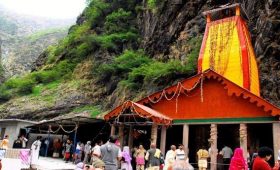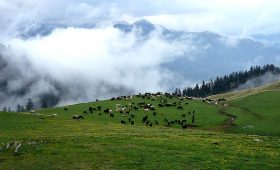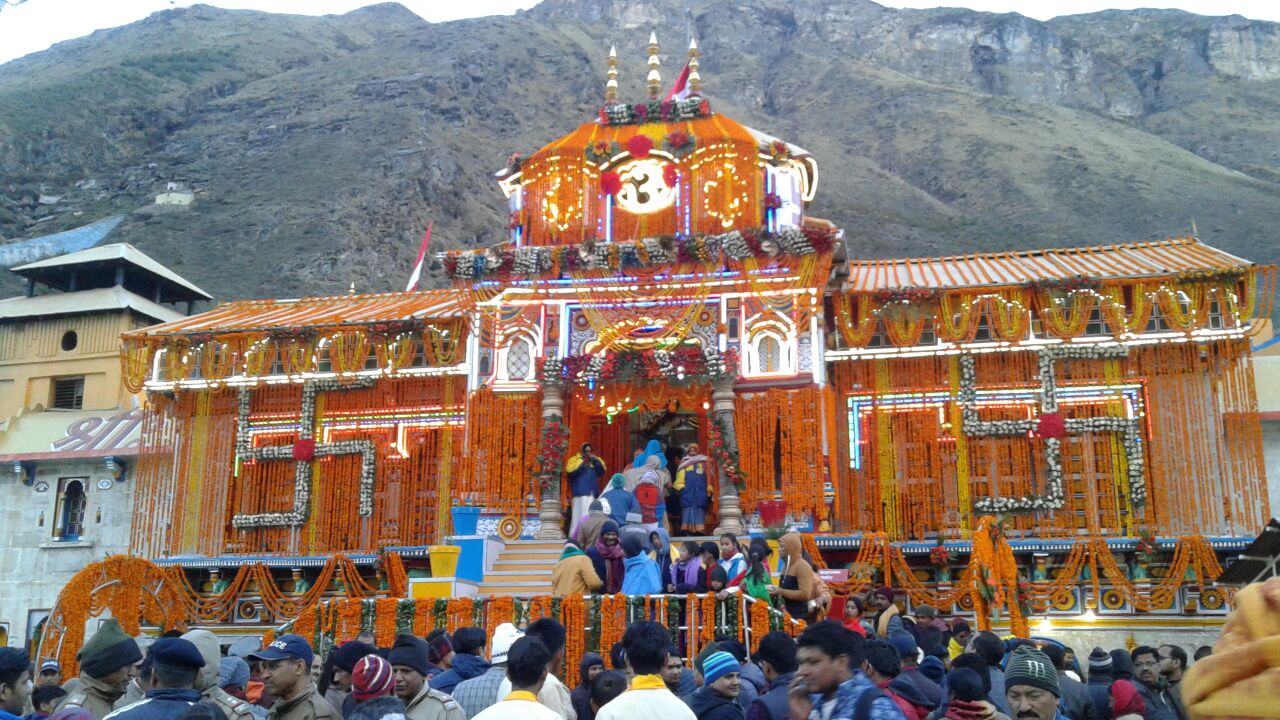Char Dham Yatra Details :-
Char Dham Yatra is referred to the four most holy Hindu pilgrimage of India nestled in Indian Himalayas of Uttarakhand state of India. Yamnotri, Gangotri, Sri Kedarnath and Sri Badrinath, collectively referred to as the Char Dham ( four pilgrimage centers) of Hinduism, these four sites are the epicenter of religious activity in north India and important shine for Hindus. These have been the most important Hindu pilgrimage centers which have been visited by devout Hindus for ages. The circuit consists of four sites. Yamnotri, the source of the Yamuna river and seat of Goddess Yamuna; Gangotri, the source of the Ganges river and seat of Goddess Ganga ; Kedarnath ,where a form of the Hindu God Shiva is acclaimed as one of the twelve jyotilinga this is the highest of the 12 Jyotirling’s – where Lord Shiva manifested himself in the form of light, it is the third of the four Dhams and the holiest of all Hindu holy places and Badrinath, the seat of the Hindu God Vishnu. Experience the divinity and mysticism of these sacred shrines as we take you a journey to’ Dev Bhumi'(Abode of Gods), Uttarakhand. Traditionally, the Chardham Yatra is undertaken from the west to the east. Thus, the Yatra starts from Yamnotri, then proceeding to Gangotri and finally to Kedarnath and Badrinath. Moreover devotees also visit Gurudwara Sri Hemkund Sahib Ji the pilgrimage site for the Sikhs and its one of the highest located religious sites in the country. Thus, pilgrims visit all these places in aspiration of washing away their sins and to attain salvation by the blessings of the Lord and ensuring the release from the cycle of birth and death. The honor conferred on these places is not surprising. These are regarded as the most sacred of all Himalayan ranges. It is also said that heaven and earth converge in these holy spots, and to be born or die here is a boon only the very fortunate have. The Chardham must be visited from left to right -beginning with Yamnotri, going on to Gangotri, then Kedarnath and culminating the journey at Badrinath. This route follows the Hindu tradition of parikrama.
Book a trip to Char Dham Yatra 2023 from Gokeys
How to Start Char Dham Yatra :-
Char Dham yatra opens on the auspicious day of Akshay Tritiya of Chaitya month and remains open until Bhai Dooj. The complete yatra will take you 11 to 12 days. If time permits, there are a lot of other diversions such as Gaumukh, Tapovan, Along valley, Bhauravnath Temple, Vasuki Tal, Chopta, Auli, and Hemkund Sahib. You can choose to start your yatra from Delhi, Haridwar, Rishikesh, or Dehradun, according to your convenience. Delhi, being the capital, is connected to all major cities. It is also just a 4-hour train ride away from Haridwar.
Char Dham yatra begins with a visit to Yamunotri Dham after a 36 km drive from Barkot, followed by a 7 km trek. Barkot also connects to Uttarkashi which is just about 100 kms from the Gangotri Dham. Kedarnath can be driven to from Rudraprayag, which is about 180 kms from Uttarkashi, followed by a 21 km trek up the mountain. Rudraprayag is also just 160 kms away from Badrinath Dham, which is the final dham in your yatra.
How to prepare yourself for Char Dham Yatra:-
There is no fixed age limit for Char Dham yatris but due to the strenous demands, the preferred age bracket is between 7 and 65 years. You will, however, require a medical certificate to validate your health condition. All Char Dham Camps are equipped with first aid boxes & oxygen cylinders, but carrying your own first-aid kit for the road is a good idea. Char Dham yatra consists of two treks – a 6 km one-way trek from Jankichatti to Yamunotri, and a 21 km one-way trek from Gaurikund to Kedarnath, so comfortable shoes with a good grip are a must! Ponies, Pithus, and Palkis are available for those not willing to or unable to trek.
Places to visit in Char Dham Yatra other than Temple
Mussoorie & Kempty Falls: Mussoorie is a hill station located 75 km from Rishikesh. It is at a height of 6,170 feet and commands an enchanting view of the snow-capped Himalayan Ranges of Uttarakhand. There are several world famous schools in Mussoorie like Woodstock School and Mussoorie International School. The major tourist attractions are Kempty Falls, Company Bagh, Gun Hill, Mall Road, etc.
Lakhamandal Temple: Lakhamandal is an ancient Hindu temple dedicated to Lord Shiva in the Jaunsar-Bawar area of Dehradun. The main attraction of the temple is the Shivlinga which is made of shining graphite. The river Yamuna flows along the Lakhamandal village. According to legend, it is believed that Duryodhana had planned to burn the Pandava brothers inside this temple.
Kashi Vishwanath Temple- Uttarkashi: Kashi Vishwanath Temple is one of the oldest temples of Lord Shiva which is located by the banks of the river Bhagirathi. It is believed that when Varanasi will get flooded with water the statue of Lord Vishwanath from the Kashi Temple will be shifted here. Inside the temple, we find statues of Shiv ji, Parvati ji, Ganesha and Nandi Bail. There are a few shops which sell necessary pooja items.
Gangnani Hotwater Springs: Gangnani is 215 km from Rishikesh, on the route to Gangotri. It is a naturally scenic place where one can peacefully meditate. You get an amazing view of the surrounding Himalayan ranges from here. The famous hot springs called Rishikund is located here. Most of the devotees visiting Gangotri take a holy dip in these waters before proceeding to the main temple.
Harsil: Harsil which is at a height of 2.600 metres lies on the route to Gangotri. It is situated at a distance of 72 km from Uttarkashi. The Bhagirathi River flows through this area. Harsil is scenically very beautiful with deodar trees and green meadows. There are several trekking routes going through Harsil. During winters the idol from Gangotri is placed in the temple of Mukhwa near Harsil.
Vishwanath Temple- Guptkashi: Vishwanath Temple is located at the centre of Guptkashi town. It is dedicated to Lord Shiva and Vishwanath literally means ‘Lord of the Universe’. It is an ancient structure built out of stone. Many tourists take darshan at this famous temple before proceeding to Kedarnath.
Triyuginarayan Temple: This temple is located in Triyuginarayan village in Rudraprayag. It is believed that Lord Shiva married Parvatiji in this temple, in the presence of Lord Vishnu. There is an eternal flame which burns day and night. It is said that this fire is burning since the time of Lord Shiva’s wedding. The structure of the temple is similar to the Kedarnath temple and was built by Adi Shankaracharya. Several tourists go to this temple by trek.
Kalimath Temple: Kalimath Temple is located in Rudraprayag district at a height of 6000 feet. It is surrounded by the mighty snow-capped peaks of Kedarnath. It is one of the 108 ‘Shakti Peeths’. This temple is dedicated to Kali Ma along with Lakshmi ji and Saraswati ji. It gets very crowded during Navratras when lakhs of devotees come to take darshan of Goddess Kali. Many Shivlingas and statues of Shiva. Parvati. Ganesha and Nandi can be seen here.
Ukhimath Temple: This temple is located at Ukhimath which is 41 km from Rudraprayag. Lord Omkareshwar is worshipped here daily. King Mandhaata had penanced for Lord Shiva here. During the winter months, the idol from Kedarnath temple is brought down to this temple in a doli. Hence Ukhimath Temple is the winter seat of Kedarnath ji. There is a building in the temple complex where the priests of the temple reside.
Chopta: Chopta is a naturally scenic village lying in Rudraprayag district. It is situated at a height of 2700 metres and commands an enchanting view of the snow clad Himalayan ranges. There are popular treks from here to Tungnath, Deoriatal and Chandrashila peak. Tungnath temple is one of the Panch Kedars located at a height of 3680mt. It the highest peak on which a Shiva temple is located.
Vridha Badri: Vridha Badri is one of the Panch Badris situated in Animath in Chamoli district. It lies at a distance of 7kms from Joshimath. In this temple Lord Vishnu is in the form of an old man- hence the name Vridha Badri. This statue was reinstated by Adi Shankaracharya around the 8th century. Many tourists come to the temple and spend time in meditating and praying to Lord Vishnu. This temple is open throughout the year.
Shankaracharya Math: Shankaracharya Math or Jyotir Math is located in Joshimath and was established around the 8th century by Adi Shankaracharya. The complex encloses the temples of Badrinarayan and Rajrajeshwari Devi. There is also a cave here where Adi Shankaracharya took tapasya. There is a 2400 years old Kalpavriksha tree in the enclosure. It is believed that Adi Shankaracharya meditated under this tree.
Narsingh Temple: Narsingh temple is one of the Sapt Badris located at Joshimath. It is located in the lower bazaar area. The idol of Lord Vishnu is in half man and half lion form and hence called as Narsingh. During winters the idol of Vishnuji from Badrinath is brought down in a doli and placed in this temple. It is believed that when the right arm of Narsingh temple falls off, the road to Badrinath will get blocked due to landslides.
Yog Dhyan Badri Temple: This temple is located at Pandukeshwar which is 24 km from Joshimath. Yog Dhyan Badri is one of the Panch Badris where Lord Vishnuji is in a meditative pose. Legend says that Kunti was married to King Pandu in Pandukeshwar. King Pandu also meditated to Lord Vishnu in this temple. The winter Utsava- Murti festival is conducted here every year when Badrinath temple is closed.
Tapt Kund: Tap Kund is located just outside the main doors of the Badrinath temple. It is a group of hot sulphur springs which has medicinal value. Devotees believe that it is necessary to take a dip in these waters before going for darshan of Badri Vishal. There are two ponds which are called Narad Kund and Surya Kund. The temperature of the water remains around 55 degrees all through the year.
Brahma Kapal: Brahma Kapal lies around 100 metres from Badrinath temple. It is an even surface on the banks of the river Alaknanda. It is believed that Lord Brahma resides here and hence people conduct shraadh ceremonies over here. It was at this place that Lord Shiva got rid of his curse after killing Lord Brahma. Mata Murthy temple is one of the famous temples located nearby.
Mana Village: Mana is a little village located at a height of 3,200 metres near Badrinath. It is the last Indian village lying before the China border which is 24 km away. Here you can visit Vyas Gufa, which is where Ved Vyas composed the Mahabharat and Ganesh Gufa is, where Ganeshji penned it. During the winter months, all the villagers migrate to lower places as Mana gets covered with snow. A huge stone bridge over the Saraswati River called Bhim Pul was supposedly placed by Bhim so that Draupadi could cross the river. Other places of interest are Mata Murthy and Vasudhara Falls.
Panch Prayag: Panch Prayag is the confluence of the five sacred rivers of Uttarakhand. They are Vishnuprayag, Karnaprayag, Nandprayag, Rudraprayag and Devprayag. The confluence is of the rivers Alaknanda, Bhagirathi, Mandakini, Dhauliganga, Nandakini and Pindar. Pilgrims take a holy dip in these Prayags before going for darshan to the major temples of Uttarakhand. All the prayags are easily accessible by road all through the year.
Auli: Auli is a hill station located 15 km from Joshimath at a height of more than 2500 metres. It is a very famous tourist location for skiing in India. The SAF Winter Games was also held here. Many professional skiers from foreign countries come to Auli for enjoying the thrills of the slopes. Garhwal Mandal Vikas Nigam organizes skiing classes for beginners. They also have a rest house for Tourists to stay. You can get amazing views of Nandadevi, Mana Parvat and Kamat from here. Auli can be reached by car or by the longest cable car ride of 4 km from Joshimath. They also have a Chair Lift and a Ski Lift.
Dhari Devi Temple: Dhari Devi temple is located on the Alaknanda River in Kalyasaur, around 15 km from Srinagar. The idol in the temple is the upper body of Goddess Dhari. It is one of the 108 Shakti Sthals of India. There is a mystery in the idol that it looks like a young girl in the mornings, like a lady in the afternoons and like an old woman after evening. People believe that the Uttarakhand disaster of 2013 took place as the priests of the temple were trying to shift the idol of Dhari Devi from its original place so that a dam could be built at the same location.
Vashishtha Gufa: Vashishtha Gufa is located 25 km from Rishikesh on the Badrinath route. It is an ancient cave where Sage Vashishtha, who was the human son of Lord Brahma, meditated. He was also one of the seven great sages of India. It is a cave where many tourists come to do deep meditation. You can also go from the Gufa to the river banks and meditate. There is an ashram in the same area called as Vashishtha Ashram.
Char Dham yatra is all about experiencing that fantasy. The journey may be long, arduous and not for the faint-hearted, but it is definitely rewarding – both spiritually and sensually. Book a trip to Char Dham Yatra from Gokeys Haridwar.




[…] Temple is a Hindu Shrine and one of the four pilgrimage destinations of Char dham Yatra carried out in Garhwal region of Uttarakhand State in India. According to historical facts the […]
[…] Dham is one of the most sacred places in India. It is one of the Char Dhams (Badrinath, Kedarnath, and Gangotri & Yamnotri) in Uttarakhand also called Chota Char Dham. […]